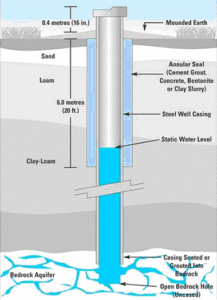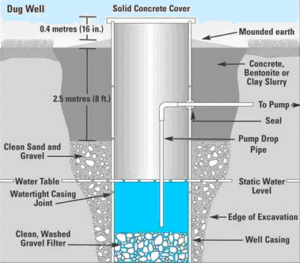Bacteria in Drinking Water
Groundwater is typically clean and safe for human consumption. The overlying soil acts as a filter eliminating disease-causing microorganisms. Nevertheless, contamination can occur following a break in the well casing, with a contaminated aquifer or because of contaminated surface water entering the well in the case of dug or bored wells.
Well water should be tested for bacteria at minimum annually, however we recommend seasonal checks especially if you keep or live near livestock or have had an adverse result in the past. Rain and snow melt can carry contaminates through the soil to your water source and since bacteria testing is offered *free through your local Ontario health unit, the extra layer of protection is certainly worth the trouble. Simply pick up a package from your local health unit and carefully follow the instructions. Please note you cannot just collect water in any container and drop it off. You must use the specially treated bottles provided. In addition, the sample should be immediately transported in a cooler or refrigerated and transported to the health unit within 24 hours.


About the Test
Microbiological activity in your water is measured by checking for the presence of total coliforms and Escherichia coli. Total coliforms occur naturally in the soil and the human gut so their presence may or may not indicate faecal contamination of the water. Drinking water should contain no more than 10 total coliforms per 100 ml of water. If your sample comes back higher than 10 a repeat sample is in order. Should the repeat sample still come back over 10, the cause should be isolated and corrective action taken as indicated.
- coli is only present in human and animal guts so its presence definitely indicates faecal contamination. The maximum level of E. coli in drinking water is 0 so any reading is cause for immediate action. Do not drink your water until you get to the bottom of it!
Corrective Action
If unacceptable levels of either total coliforms or E. coli are found in your water, find another source of water or boil for at least a minute before drinking. Shock treating the well is your first step. Full instructions can be found on the Health Canada website or you can call a professional water treatment company to do this for you. After 48 hours, resample the water. Two consecutive safe tests over one to three weeks are a good result, but you should follow up with resampling in 3 months. If shocking does not correct the problem, the source of the ongoing contamination should be found and corrected, or preventative treatment considered.
Water Treatment Options
There are several ways to treat contaminated water, but the most common are Ultraviolet light and chlorination. Both require microfiltration to improve inactivation of microorganisms and remove particulates, including parasites. If your water has high levels of hardness (calcium/magnesium) or iron additional pre-filtration may be necessary as well. Chemical free UV is the simplest to manage and most often recommended. Annual bulb and pre-filter changes as recommended will provide your family with safe, potable water for years to come.
*Quebec does not offer this service; you will need to use an accredited lab. See link below.

LINKS:
Ministry of Sustainable Development, Environment, and Action against Climate Change
http://www.mddelcc.gouv.qc.ca/eau/potable/depliant/index-en.htm#tested
Public Health Ontario
https://www.publichealthontario.ca/en/ServicesAndTools/LaboratoryServices/Pages/Water-Testing-ProtectYourWater.aspx
Our UV Suppliers:
Greenway Water Technologies
http://www.greenwaywt.com/products/ultraviolet_disinfection_systems
Luminor Environmental
http://www.luminoruv.com/

